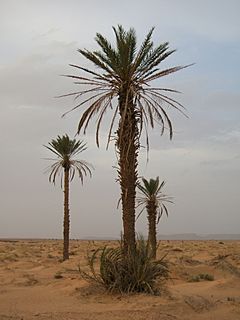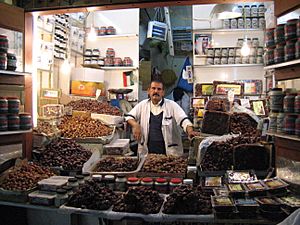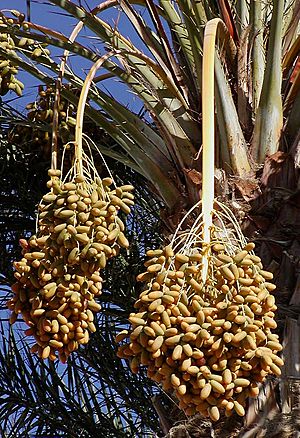Date Palm facts for kids
Quick facts for kids Date Palm |
|
|---|---|
 |
|
| Phoenix dactylifera | |
| Scientific classification | |
| Kingdom: | |
| Division: | |
| Class: | |
| Order: | |
| Family: | |
| Genus: |
Phoenix
|
| Species: |
P. dactylifera
|
| Binomial name | |
| Phoenix dactylifera |
|

The Date Palm is a tall tree famous for its sweet, edible fruit called dates. People have grown these trees for a very long time because dates are a popular food. Date Palms can grow quite tall, usually between 15 and 25 meters (about 50 to 80 feet) high. They have long, feathery leaves, which are called pinnate leaves. These leaves can be 3 to 5 meters long and have sharp spines. A single tree can have a wide crown, spreading out 6 to 10 meters. Date Palms often have one or more trunks that all grow from the same root system.
Growing Dates Around the World
Date Palms are grown in many parts of the world, especially in warm, dry climates. In 2004, about 6.7 million tonnes of dates were produced globally. The FAO tracks these numbers. Here are some of the top countries that grow dates:
- Egypt: 1,100,000 tonnes (16.2% of all dates)
- Iran: 880,000 tonnes (13.0%)
- Saudi Arabia: 830,000 tonnes (12.3%)
- United Arab Emirates: 760,000 tonnes (11.2%)
- India: 710,000 tonnes (10.6%)
- Pakistan: 650,000 tonnes (9.6%)
- Algeria: 450,000 tonnes (6.6%)
- Sudan: 330,000 tonnes
- Oman: 240,000 tonnes
- Libya: 140,000 tonnes
- Other countries: 1,140,000 tonnes
Iraq used to be a very big producer of dates. However, in recent years, their production and exports have gone down a lot.
Images for kids
-
Phoenix dactylifera trunk section. Like other palm trees, date palms do not produce tree rings.
-
Sweet sap tapped from date palm in West Bengal, India
-
Dried date, peach, and apricot from Lahun, Fayum, Egypt. From the late Middle Kingdom.
See also
 In Spanish: Palmera datilera para niños
In Spanish: Palmera datilera para niños











